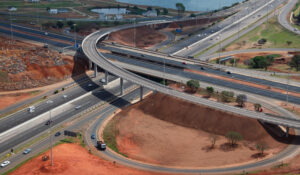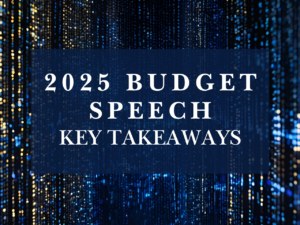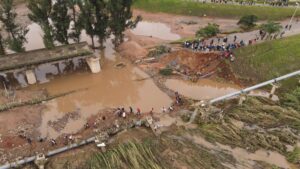Infrastructure development is the cornerstone of the Government of National Unity‘s (GNU) strategy to boost investment in the economy, which has stagnated for over a decade.
Public infrastructure spending over the next three years will amount to more than R1 trillion
This means an additional R85 billion was allocated to infrastructure over the three-year period. Allocations to water and sanitation were surprisingly cut by R4.6 billion over the next three years, compared to 2024 estimates.
Spending will focus on three sectors:
- R402 billion for transport and logistics
- R219.2 billion for energy infrastructure
- R156.3 billion for water and sanitation.
1. Transport and logistics

Pretoria, Gauteng / South Africa – 11/06/2010: Aerial N1 R21 Interchange
In transport, the
South African National Roads Agency (SANRAL) will spend
R100 billion over the medium term to keep the national road network in good condition. Provincial roads departments will reseal over 16 000 lane kilometres of roads in their areas of authority.
The
Passenger Rail Agency of South Africa (PRASA) is making steady progress to rebuild infrastructure to provide affordable commuter rail services. To sustain this progress, an additional R19.2 billion is allocated over the medium term for critical signalling upgrades. This will enable commuters from areas like Mamelodi, Kwa-Mashu, Motherwell and Khayelitsha to catch a train every 10 minutes, to get to and from work and significantly reduce the money that low-income households spend on transport.
The allocation will also allow PRASA to maximise the potential of the 241 new trains delivered through the rolling stock renewal programme. Despite the progress made, PRASA’s procurement system needs strengthening. The management of the entity have already instituting measures to strengthen their procurement weaknesses. This includes getting support from the National Treasury to build capacity and mitigate risks and undertaking live audits for large procurement projects.
2. Energy
 R219.2 billion will be spent on energy infrastructure over the next three years.
R219.2 billion will be spent on energy infrastructure over the next three years.
The Eskom debt relief arrangements are also effective and contribute to the improved fiscal position. Eskom is now in a much better financial position than in 2023 when the debt relief was originally announced. As a result of these improvements, government has simplified the final phase of the debt relief package. The last R70 billion debt takeover will now be replaced with R40 billion in 2025/26, and R10 billion in 2028/29. This will result in a saving for the government of about R20 billion.
The energy reforms have created a 22 500 mega-watt pipeline of projects. More than 10 000 mega-watts are formally registered with the NERSA, which is one of the last steps in the regulatory process. These projects will contribute to reducing power cuts.
The Independent Transmission Programme will be launched later this year. A request for information for a multi-line transmission package will also be issued by the Independent Power Producers Office in July this year, followed by a request for proposals in November. These will enable the private sector to play a key role in the expansion of the transmission network.
3. Water
The water-use licenses backlog has been cleared, unlocking billions in investment and freeing projects that had stalled because of the backlog. The water quality regulatory system was reinstated for the first time since 2014. This is the Green Drop, Blue Drop and No Drop certification that enables effective intervention in supporting failing municipalities to provide clean water to citizens.
The Mkhomazi Project is expected to commence construction in November 2027, transferring water to the Mngeni Water Supply System. This will increase the total capacity of the system to 5 million households in eThekwini and 4 district municipalities in KwaZulu Natal. The Berg River-Voëlvlei Augmentation Scheme is expected to start in July 2026. The project will improve the Western Cape’s Water Supply System, improving regional water security while reliably supplying domestic, agricultural and industrial water users.
The Budget allocates
R1.7 billion to respond to future disasters over the medium term, while R4 billion is provisionally allocated to address backlogs in recovery efforts for provinces and municipalities.
It was noted in the budget speech that South Africa’s current disaster management system is skewed towards relief and rehabilitation, while mitigation and readiness to minimise damage is the most cost effective response. Municipalities stand at the frontline of disaster response yet they are hamstrung by aging infrastructure, bureaucratic fragmentation, and limited access to emergency funds.
Reducing the administrative burden to access emergency funds has been made a priority as every hour of delay costs lives and livelihoods. Continuous improvements are being made to the grant system to incentivise municipalities to access a variety of funding instruments for disasters. These include their own budget, the contingency reserve, conditional grant funding and insurance.
State owned enterprises
The Budget Review said state-owned companies, public entities, and municipalities would fund 72.7%, or
R748.5 billion, of total medium-term public sector capital investment from their budgets.
The decline in municipal services is evident across cities, towns and rural villages highlighting the systemic challenges faced by this varying group of municipalities.
Reforms to the revenue generating services of local government, namely water and sanitation, electricity and refuse removal are underway. By ring-fencing the revenues from these services, and running operating surpluses, these business units can generate funds for infrastructure improvements to deliver quality and reliable services.
Six of the eight metropolitan municipalities have met the minimum requirements to participate in the financial performance incentive grant, the Urban Development Financing Grant. Further allocations in the programme are dependent on municipalities meeting specific targets related set out in their performance improvement action plans.
PPPs and improved infrastructure financing
The new regulations for public-private partnerships (PPPs) have been finalised and will take effect on 1 June 2025. The regulations reduce the procedural complexity of undertaking PPPs, create capacity to support and manage PPPs, create clear rules for managing unsolicited bids, and strengthen fiscal risk governance. The regulations also make provision for national departments to establish sector-specific PPP units. These units will drive private sector participation (PSP), creating opportunities to optimise the balance sheets of financially distressed state-owned companies
There are efforts to diversify the financing strategy to support infrastructure will also lead to the launch of a credit guarantee vehicle in 2026 to mobilise private sector capital by derisking projects. Government’s initial focus will be on independent transmission aimed at bridging the energy transmission deficit, but once the vehicle has demonstrated its efficacy, it will be broadened to include other sectors.
The first infrastructure bond will be issued in 2025/26 and introduce other innovative financing instruments to diversify the infrastructure funding sources. Financial institutions, including pension funds, banks, development banks and international financial institutions, have already expressed interest in participating.

 R219.2 billion will be spent on energy infrastructure over the next three years.
The Eskom debt relief arrangements are also effective and contribute to the improved fiscal position. Eskom is now in a much better financial position than in 2023 when the debt relief was originally announced. As a result of these improvements, government has simplified the final phase of the debt relief package. The last R70 billion debt takeover will now be replaced with R40 billion in 2025/26, and R10 billion in 2028/29. This will result in a saving for the government of about R20 billion.
The energy reforms have created a 22 500 mega-watt pipeline of projects. More than 10 000 mega-watts are formally registered with the NERSA, which is one of the last steps in the regulatory process. These projects will contribute to reducing power cuts.
The Independent Transmission Programme will be launched later this year. A request for information for a multi-line transmission package will also be issued by the Independent Power Producers Office in July this year, followed by a request for proposals in November. These will enable the private sector to play a key role in the expansion of the transmission network.
R219.2 billion will be spent on energy infrastructure over the next three years.
The Eskom debt relief arrangements are also effective and contribute to the improved fiscal position. Eskom is now in a much better financial position than in 2023 when the debt relief was originally announced. As a result of these improvements, government has simplified the final phase of the debt relief package. The last R70 billion debt takeover will now be replaced with R40 billion in 2025/26, and R10 billion in 2028/29. This will result in a saving for the government of about R20 billion.
The energy reforms have created a 22 500 mega-watt pipeline of projects. More than 10 000 mega-watts are formally registered with the NERSA, which is one of the last steps in the regulatory process. These projects will contribute to reducing power cuts.
The Independent Transmission Programme will be launched later this year. A request for information for a multi-line transmission package will also be issued by the Independent Power Producers Office in July this year, followed by a request for proposals in November. These will enable the private sector to play a key role in the expansion of the transmission network.




 Disaster Management
Disaster Management

